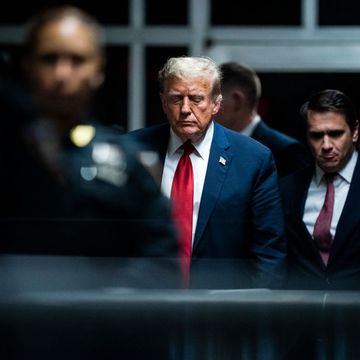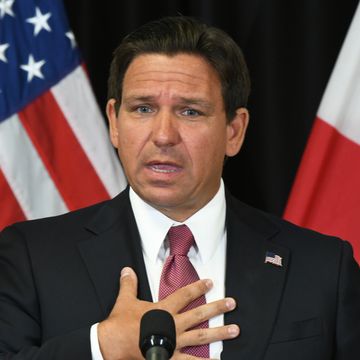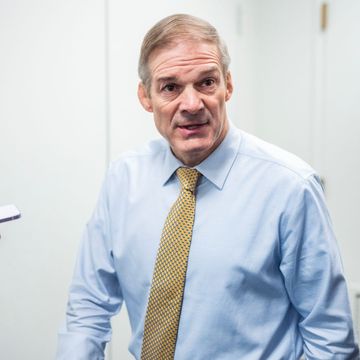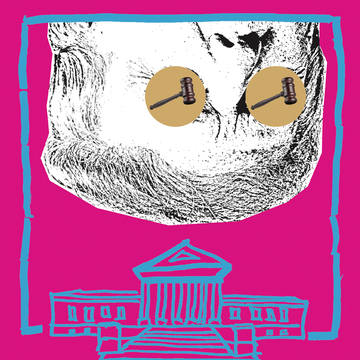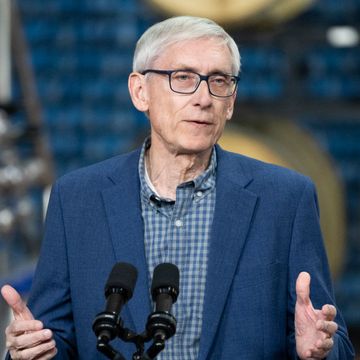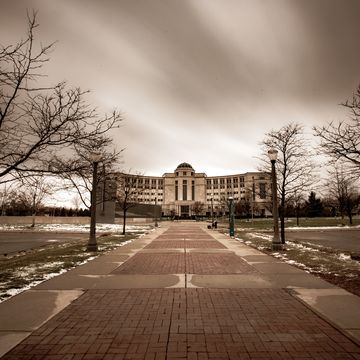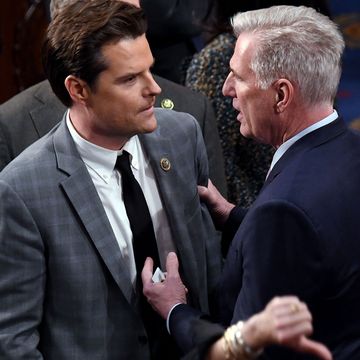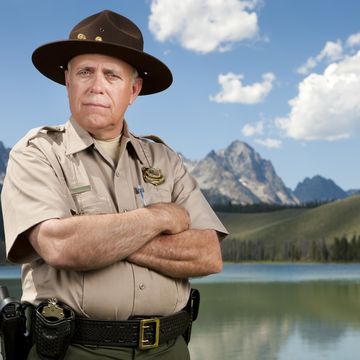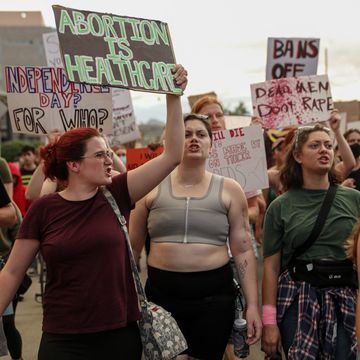The tooth came last. It came home two years ago, and once it did Eulogia Hernandez knew that the rest of her husband Norberto would never follow. She knew that he was gone because she knew that he was complete, and she could finally stop dreaming of his return.
It was the dream that had kept her alive, in the days after Norberto disappeared when the buildings fell down, and it was the dream that had started killing her in the years since she and her three daughters had began returning pieces of him to the grave in Puerto Rico. All she had ever wanted — the only mercy she had ever asked for — was the knowledge that her husband was trying to come home when he died, that he was trying to reach her and the girls. That's why they suffered so when that newspaper reporter looked at that terrible picture of the man falling through the sky and said that the man was Norberto. The man in that photo wasn't trying to come home. He was falling. The man in that photo wasn't Norberto.
Eulogia feared for her sanity, when people kept saying that it was — that she didn't know what she knew. Her daughters, too. The youngest, Tatiana, was fifteen at the time. She began hearing voices, because she began listening to the people who said that her father was the man in the picture. "I thought it was true," she says now. "It looked like him, with the uniform and everything. So I didn't know who to believe, who to trust. I didn't know who was who, and if I could believe my own family..."
It got better, after it was proven that the newspaper reporter made a mistake — after, in the words of Tatiana's older sister Catherine, "my father's name was cleared." And it got better when they began bringing Norberto back home to Puerto Rico. "It sounds morbid," says Catherine, "but we have him almost complete. We have his legs, we have his skull, his torso, and an arm. And it means a lot to us, because he's there. We alternate every year, at the anniversary — one year in New York, at Ground Zero, and one year in Puerto Rico. This year, it's New York. But when we go to New York, it's out of respect for my father and for the others who died. When we go to Puerto Rico, it's for comfort. There is much more comfort in the place where he's at rest than in the place where he was killed."
And yet even when Norberto began going home to Puerto Rico, Eulogia couldn't let go of the dream that he still might go home to her. "My mother couldn't talk about him, and you couldn't talk to her," Tatiana says. "She would get so emotional. She was stuck in her own little world. She kept wondering, 'What if he's lost somewhere? What if he's wandering the streets and doesn't know he is?' The false hope of him coming home was driving her crazy."
The tooth lifted the curse, even more than the article in Esquire that said he wasn't the man in the picture, the Falling Man. After the tooth was sent to her two years ago, she decided to talk to someone — to do what she'd always refused to do, and get help. She even called Norberto's sister, to tell her that the last of her brother had made it home. She hadn't spoken to Norberto's sister in eight years. She hadn't spoke to her since Norberto's sister had responded to the newspaper reporter's entreaties, had looked at the picture of the Falling Man that had been proffered to her and had said, "Yes, that's my brother. That's Norberto." Now Eulogia called her about the tooth, and kept calling her until, as Catherine says, "little by little, they came back together. They reconciled. They don't talk all the time, like they used to, but they talk. My father's sister is my aunt again."
They brought the tooth down to Puerto Rico last year, and buried it with the rest of Norberto Hernandez, in the place where he was born. And now they are what Norberto wanted them to be, together. They all live in the Long Island town where they moved after 9/11, Eulogia living in the same house with Tatiana and Jackie, her oldest daughter, and Jackie's five children; and around the block from Catherine, who's married with two kids of her own. Jackie's a doctor's assistant, studying to become a nurse; Catherine's a police officer in Queens; and Tatiana's studying to become a commercial pilot on Long Island after putting aside her dream to join the Air Force — after realizing that she could never leave her mother, or her sisters, or the memory of Papi.
Are they healed? They are not, even though Eulogia can now whisper on the phone that "I accept the reality that I am here alone with my three daughters." For one thing, they still do not think that the photograph that Richard Drew took of the Falling Man should ever have been published. "I won't look at it," Catherine says. "For the families, it should have been kept in a vault, kept for themselves. And I think that every family would agree. It's a horrific image. The first time I saw it, my heart dropped; I literally felt sick to my stomach. To think that someone had to go through that. And then when people started saying that the man in the photo was my father..."
For another, they believe that they are expected to feel different somehow, with the arrival of the tenth anniversary. They do not feel different. "The tenth feels the same as the ninth, feels the same as the eighth," Catherine says. "And it all feels the same as the day after. My father's gone, and he's never coming back. That's what it feels like."
They do not feel comforted by what is supposed to comfort them — by the completion of the memorial and the construction of another tower in the place where the towers fell — for what the world regards as an act of memory, the Hernandezes regard as the start of the inevitable forgetting. "I personally disagree with them building another building there," Jackie says. "I personally feel that that piece of land should be sacred, that they should build a cemetery and leave it alone. But nobody cares what the families say, to be honest with you. They do what they want to do. The government doesn't take us into consideration for anything. Their consideration is getting the finances back up. It's beyond painful. They build again, and God forbid there's another attack. Then what? They should just leave it alone. Just leave it alone."
*****
Courtesy of the Smithsonian Museum
Jonathan Briley's pager is supposed to be getting back home soon.
Gwendolyn Briley Strand works in Washington, D.C. — what she calls "the epicenter of memorials" — and knows what cold comfort memorials bring. "They're never the way that the families, the grieving people, deal with their loss," she says. "They're the way the world deals with its loss. They're not for us. They're for the rest of the country, and they're for history."
Nevertheless, Gwendolyn is going to be in New York with her family on Sunday, to see the memorial, and to hear, once again, the reading of the name of her brother Jonathan. "I've gone every year," she says, "because of the feeling that's there, among the families. You know, everyplace I go, if I tell people I lost someone on 9/11, I hear the same thing: 'Oh, you're the first person I've met who has.' Well, at Ground Zero, everyone's lost someone. It's the only place I can go where I'm not the odd man out."
And yet there's something that distinguishes Gwendolyn from all the other grieving family members who will observe the tenth anniversary of the attacks on Sunday morning — the fact that her brother, Jonathan, has been made to stand for all. She and her family have changed places with the Hernandezes; the same Esquire article that "cleared" Norberto Hernandez of being the Falling Man made the provisional case that it was Jonathan Briley. The memorial that will stand for all the others murdered that day is on the ground; the memorial for Jonathan is in the sky, or in the infinitely replicable pixels of a digital photograph.
"The first time I looked at that photograph, it took my breath away," she says. "Now I am quite at peace with it not being Jonathan."
You see, she has Jonathan, in the same way that the Hernandezes have Norberto; and at the same time she knows that no one does. A few days after the attacks, her father, the Rev. Alexander Briley of the Shiloh Baptist Church in New Rochelle, made, for the first time in his life, a public demand of God. He demanded that God restore his son to him — that God deliver the miracle that would deliver to him a body to bury. God answered his furious prayer; and from the dust and the rubble came what Gwendolyn calls "Jonathan's full form." Afterwards, Reverend Briley used to say that God gave him exactly the miracle he asked for, but he asked for the wrong one. He should have asked for the return of Jonathan, alive.
Now Jonathan is buried in Mt. Kisco, next to his mother, who died in 2009. But Gwendolyn doesn't visit him there, because he is not there, any more than he is there in Richard Drew's photograph. "I believe in the trinity of the human being — mind, body and spirit. And I know that after the death of the body, he's not there. He's in God's hands."
In the same way, he's not in the photograph of the Falling Man. "People have to get over wondering who this man was," she says. "He's everybody. We're so stuck on who he was that we can't see what's right there in front of us. The photo's so much bigger than any man, because the man in the photo is clearly in God's hands. And it's God who gives us the grace to go on."
Gwendolyn does wonder, however, about her father. Reverend Briley was diagnosed with Parkinson's shortly after the death of his wife, and the disease has progressed rapidly. "He hasn't been out of bed in a year, and I'm not sure if he knows what's happening on Sunday. But maybe that's another of God's mercies. I think of Jonathan dying at forty-three, and then my father getting to this stage in his life. Which is the better way? Jonathan's death took so much out of my father. Maybe it's good where he is right now."
As for Jonathan, he is everywhere, and he belongs to everybody. "They recovered some of his personal effects, and they're at the Smithsonian," Gwendolyn says. "I have the bracelet he wore that day. But they have his pager, his ID card, and his keys. And they have gone all over the world, in a traveling exhibition. It started here, in Washington. But it's traveled all over the world. It's supposed to be getting back home soon. Maybe it already has."
EARLIER: "The Falling Man"
UPDATE: Mad Men and "The Falling Man"



